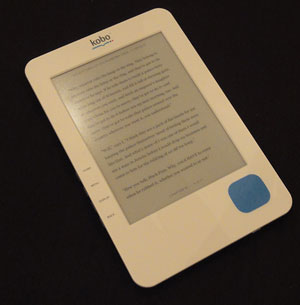 Joanna just did an interview with the CEO of Kobo (more later) and came away with a loaner reader. If anyone has any questions about it post them here in the comments and she’ll try to answer them.
Joanna just did an interview with the CEO of Kobo (more later) and came away with a loaner reader. If anyone has any questions about it post them here in the comments and she’ll try to answer them.
© Copyright 2016 TELEREAD - For people who love books and gadgets. Est. 1995. Website Design & Marketing Credits
































Will it support DOC and JPG files?
When will it exactly comes out in the U.S??
How fast is the page turn (compared to Kindle)? I’ve found e-ink reader turn speeds are highly software-dependent.
That’s pretty cool. I don’t have any particular questions, per-se, but rather a request: any likes? Dislikes? I just pre-ordered one, and am hopeful that someone who actually *has* one can validate my purchase.
Thanks!
-Ken
The blue band-aid on the reader looks incredibly ugly when compared with some of the better looking offerings (e.g. Sony). In fact it looks like a cheap Chinese knockoff. They need to improve the looks of the device or no one is going to buy!
How do you hold this device? Can you hold it and operate it with one hand? Do you have to stop reading to pick up a coffee cup and take a sip?
Will it be sold in Europe, too?
Does it support on-screen dictionary function?
It says it supports e-pub, but what about timed digital ARC’s in Adobe Digital Editions from the publisher? How easy is it to get them on the device and what font does it show up in on the reader? That is the one thing my Kindle can’t do and I don’t like reading them on the computer. I’ve tried a couple of other devices and the font on the ARC’s were so small I couldn’t read them.
How is PDF handling? Does it have reflow? What other PDF features does it have?
Does it read Hebrew ePubs properly?
I know they does not claim to support it but you can never tell…
Please let me know if you would like me to send you a Valid Hebrew ePub.
Can’t wait for the release!
Will it work with Linux?
For instance, will it be possible to plug the eReader into a USB port and drag and drop books as easy as if it were a standard thumb drive or MP3 player?
Or, will proprietary client software be necessary?
Will it be compatible with ePubs checked out through a public library system? This is the only thing holding me back from pre-ordering.
It should be, as long as you properly authorize the reader with ADE.
I would greatly appreciate it if the following questions can be answered:
1) What is the refresher rate for the e-ink? Does it feel slow or fast?
2) Can it be used to access public library’s protected PDF or EPub books? (such as the Nook and Sony’s new ebook reader series)
3) Can it read PDF files properly without affecting the page turning speed?
Thanks!
1) Slow compared to the Kindle. On par with my old Sony 505
2) Yes
3) Yes, but I really don’t think a small screen is the best PDF experience anyway so I did not extensively test it
I just purchased the Kobo and I noticed that when the page turns or you go to a new screen, it goes black and blury for a second. is that normale, or is there something wrong with my Kobo?
Steph: that’s how eInk works, regardless of viewer.
To answer someone else’s question, no, it doesn’t work under Linux, and WINE doesn’t do the trick, either — though perhaps someone with more impetus can figure that out. (It seems to be a path issue.)
All things being equal? Loving my Kobo.
More precisely, that is the *default* way eink panels are driven to ensure a clean transition from page to page.
On some readers it is possible to change this behavior. The result isn’t (theoretically) as clean and there is a possibility of ghosting (remnants of the old page showing on the new) but the result on my Pocketbook 360 in that mode was surprisingly good when I tried it; no visible garbage at all.
That said, the “black flash” is something you get used to and it drops out of most people’s conscious perception surprisingly fast.
Does it support Chinese text files?
Chinese, Japanese, Hebrew, and Thai.
The required fonts are free downloads here:
http://www.pocketbook-usa.com/support/pocketbook-360/
Also, the (Very lean) user manual, free dictionaries, and the latest firmware. There is a dedicated user Forum over at mobileread.com that is very helpful exploring the various Pocketbook models.
The question was about Kobo reader and not Pocketbook.
I don’t know about Chinese, but the Kobo reader does not support Hebrew ePub properly. It display the text in reverse order (it doesn’t support properly the RTL tags and style).
Sorry. Coming after my previous answer, I misunderstood. Not looking to hype anything, okay?